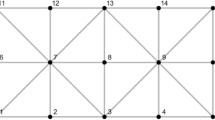Abstract
The assembly deformation of skin panels can be introduced by the riveting process. However, it is computationally costly and time consuming to conduct the numerical simulation of the riveting process for each rivet in skin panels. Here, an equivalent mechanical model of the riveting process is established to improve the computational efficiency of the deformation prediction for the riveted structure. The axial pressure beneath the rivet driven head is solved in the equivalent mechanical model. The assembly deformation of riveted panels is found to be influenced by the axial pressure significantly, challenging the traditional analogy of riveting to the radial expansion process. In addition, the dependence of the radial pressure upon the radial displacement of the rivet hole is established. The characteristic of non-uniform distribution of the radial pressure along the thickness direction is taken into consideration. The deformations of riveted structures are predicted considering various heights of the rivet driven head and different materials of the panel. The effectiveness of the proposed model is evaluated by comparing the deformation results of the numerical simulation and those of the experimental measurement. This investigation can help to predict the deformation of large riveted structures and improve the awareness of the effect of axial pressure on the assembly deformation.
Similar content being viewed by others
References
Neugebauer R, Rössinger M, Wahl M, Schulz F, Eckert A, Schützle W (2011) Predicting dimensional accuracy of mechanically joined car body assemblies. Key Eng Mater 473:973–980
Eckert A, Israel M, Neugebauer R, Rössinger M, Wahl M, Schulz F (2012) Local–global approach using experimental and/or simulated data to predict distortion caused by mechanical joining technologies. Prod Eng Res Devel 7(2-3):339–349
Cai W, Wang PC, Yang W (2005) Assembly dimensional prediction for self-piercing riveted aluminum panels. Int J Mach Tool Manuf 45(6):695–704
Lambiase F (2013) Influence of process parameters in mechanical clinching with extensible dies. Int J Adv Manuf Technol 66(9-12):2123–2131
Aman F, Cheraghi SH, Krishnan KK, Lankarani H (2013) Study of the impact of riveting sequence, rivet pitch, and gap between sheets on the quality of riveted lap joints using finite element method. Int J Adv Manuf Technol 67(1-4):545–562
Cheng H, Li Y, Zhang KF, Mu WQ, Liu BF (2011) Variation modeling of aeronautical thin-walled structures with multi-state riveting. J Manuf Syst 30(2):101–115
Negroni DY, Trabasso LG (2011) A replicated two-level total factorial analysis: deformation in aluminum alloy skins caused by riveting processes. Prod Manage Dev 9(1):59–70
Saadat M, Cretin L, Sim R, Najafi F (2007) Prediction of geometrical variations in Airbus wingbox assembly. Assembly Autom 27(4):324–332
Li G, Shi G, Bellinger NC (2011) Stress in triple-row riveted lap joints under the influence of specific factors. J Aircraft 48(2):527–539
Lin J, Jin S, Zheng C, Li ZM, Liu YH (2014) Compliant assembly variation analysis of aeronautical panels using unified substructures with consideration of identical parts. Comput Aid Des 57:29–40
Wang H (2014) Riveting sequence study of horizontal stabilizer assembly using finite-element analysis and riveting equivalent unit. J Aerosp Eng 27(6):04014040
Rans DC, Straznicky PV, Alderliesten R (2007) Riveting process induced residual stresses around solid rivets in mechanical joints. J Aircraft 44(1):323–329
Viganò F, Manes A, Giglio M (2011) Investigation on the fatigue life of an Al 8090 helicopter riveted T-joint. J Aircraft 48(1):315–323
Li G, Shi G, Bellinger NC (2006) Studies of residual stress in single-row countersunk riveted lap joints. J Aircraft 43(3):592–599
Rans DC (2007) The role of rivet in stallation on the fatigue performance of riveted lap joints. Ph.D. Dissertation, Carleton Univ, Ottawa, Canada
Shishkin SS (2010) Computation of the contact load in a rivet bond. J Mach Manuf Reliab 39(1):43–46
Chang JB (1977) Prediction of Fatigue Crack Growth at Cold-worked Fastener Holes. J Aircraft 14(9):903–908
Ball DL (1995) Elastic-plastic stress analysis of cold expanded fastener holes. Fatigue Fract Eng Mater Stru 18(1):47–63
Saadat M, Cretin L, Sim R, Najafi F (2009) Deformation analysis of large aerospace components during assembly. Int J Adv Manuf Technol 41(1-2):145–155
Cheraghi SH (2008) Effect of variations in the riveting process on the quality of riveted joints. Int J Adv Manuf Technol 39(11-12):1144–1155
Manes A, Giglio M, Viganò F (2011) Effect of riveting process parameters on the local stress field of a T-joint. Int J Mech Sci 53(12):1039–1049
Dowling NE (2007) Mechanical behavior of materials, 3rd edn. Prentice Hall, Upper Saddle River
Rans DC, Straznicky PV, Alderliesten R (2007) Effects of rivet installation on residual stresses and secondary bending stresses in a riveted lap joint. Proc 48th AIAA/ASME/ASCE/AHS/ASC Struct, Struc Dynam. Mater Conf 13:189–203
Yu HQ, Chen JD (1999) The principle of metal plastic forming. China Machine Press, Beijing
Derijck J, Homan J, Schijve J, Benedictus R (2007) The driven rivet head dimensions as an indication of the fatigue performance of aircraft lap joints. Int J Fatigue 29(12):2208–2218
Wang R, Huang WB, Huang ZP (1992) Introduction to plasticity. Peking University Press, Beijing
Xu BY, Liu YS (1995) Application of elastic and plastic mechanics. Tsinghua University Press, Beijing
Liang K (2013) Interference Calculation and Process Validation of Aircraft Panel Riveted Structure. Master Dissertation, Nanjing University of Aeronautics and Astronautics, Nanjing, China
Deng X, Hutchinson JW (1998) The clamping stress in a cold-driven rivet. Int J Mech Sci 40(7):683–694
Yuan L (2010) Aviation manufacturing engineering handbook:Aircraft assembly, 2nd edn. Aviation Industry Press, Beijing
Li YH, Cao ZQ, Zhang QL, Feng DG (2013) Study on the effect of riveting quality with different angles of the forming cup of riveting die. Acta Aeronaut et Astronaut Sinica 33(2):426–433
Park JH, Atluri SN (1993) Fatigue growth of multiple-cracks near a row of fastener-holes in a fuselage lap-joint. Int J Computation Mech 13:189–203
Author information
Authors and Affiliations
Corresponding author
Rights and permissions
About this article
Cite this article
Zheng, B., Yu, H. & Lai, X. Assembly deformation prediction of riveted panels by using equivalent mechanical model of riveting process. Int J Adv Manuf Technol 92, 1955–1966 (2017). https://doi.org/10.1007/s00170-017-0262-9
Received:
Accepted:
Published:
Issue Date:
DOI: https://doi.org/10.1007/s00170-017-0262-9




